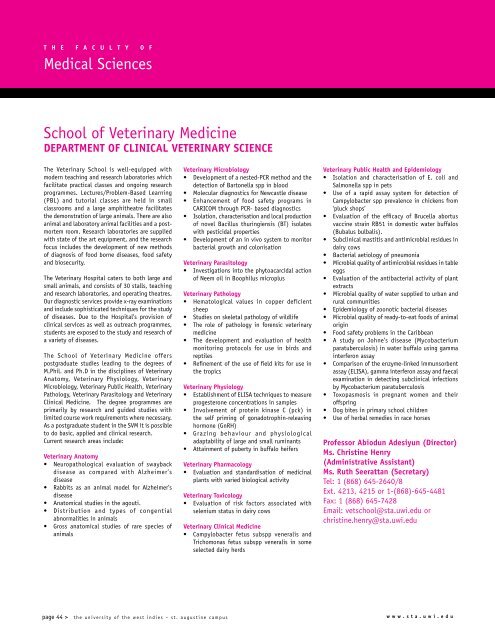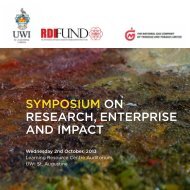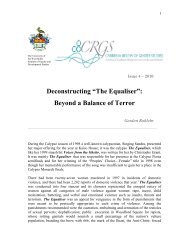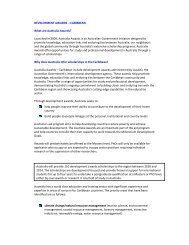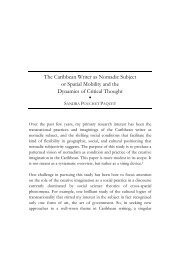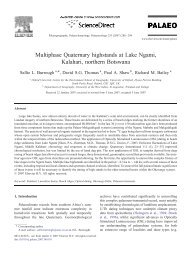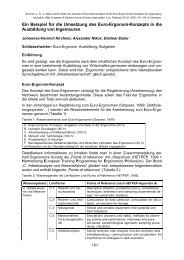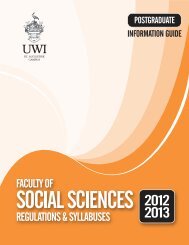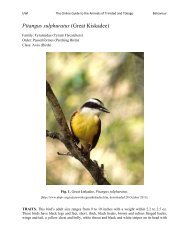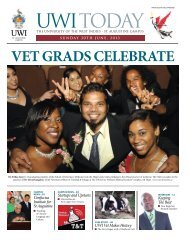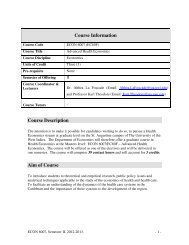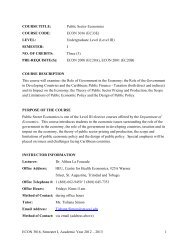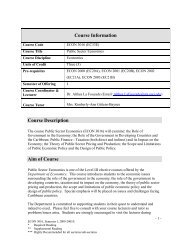postgraduate prospectus - The University of the West Indies, St ...
postgraduate prospectus - The University of the West Indies, St ...
postgraduate prospectus - The University of the West Indies, St ...
You also want an ePaper? Increase the reach of your titles
YUMPU automatically turns print PDFs into web optimized ePapers that Google loves.
T h e f a C u l T Y o f<br />
Medical Sciences<br />
School <strong>of</strong> Veterinary Medicine<br />
DeParTmenT <strong>of</strong> CliniCal VeTerinarY SCienCe<br />
<strong>The</strong> Veterinary School is well-equipped with<br />
modern teaching and research laboratories which<br />
facilitate practical classes and ongoing research<br />
programmes. Lectures/Problem-Based Learning<br />
(PBL) and tutorial classes are held in small<br />
classrooms and a large amphi<strong>the</strong>atre facilitates<br />
<strong>the</strong> demonstration <strong>of</strong> large animals. <strong>The</strong>re are also<br />
animal and laboratory animal facilities and a postmortem<br />
room. Research laboratories are supplied<br />
with state <strong>of</strong> <strong>the</strong> art equipment, and <strong>the</strong> research<br />
focus includes <strong>the</strong> development <strong>of</strong> new methods<br />
<strong>of</strong> diagnosis <strong>of</strong> food borne diseases, food safety<br />
and biosecurity.<br />
<strong>The</strong> Veterinary Hospital caters to both large and<br />
small animals, and consists <strong>of</strong> 30 stalls, teaching<br />
and research laboratories, and operating <strong>the</strong>atres.<br />
Our diagnostic services provide x-ray examinations<br />
and include sophisticated techniques for <strong>the</strong> study<br />
<strong>of</strong> diseases. Due to <strong>the</strong> Hospital’s provision <strong>of</strong><br />
clinical services as well as outreach programmes,<br />
students are exposed to <strong>the</strong> study and research <strong>of</strong><br />
a variety <strong>of</strong> diseases.<br />
<strong>The</strong> School <strong>of</strong> Veterinary Medicine <strong>of</strong>fers<br />
<strong>postgraduate</strong> studies leading to <strong>the</strong> degrees <strong>of</strong><br />
M.Phil. and Ph.D in <strong>the</strong> disciplines <strong>of</strong> Veterinary<br />
Anatomy, Veterinary Physiology, Veterinary<br />
Microbiology, Veterinary Public Health, Veterinary<br />
Pathology, Veterinary Parasitology and Veterinary<br />
Clinical Medicine. <strong>The</strong> degree programmes are<br />
primarily by research and guided studies with<br />
limited course work requirements where necessary.<br />
As a <strong>postgraduate</strong> student in <strong>the</strong> SVM it is possible<br />
to do basic, applied and clinical research.<br />
Current research areas include:<br />
Veterinary anatomy<br />
• Neuropathological evaluation <strong>of</strong> swayback<br />
disease as compared with Alzheimer’s<br />
disease<br />
• Rabbits as an animal model for Alzheimer’s<br />
disease<br />
• Anatomical studies in <strong>the</strong> agouti.<br />
• Distribution and types <strong>of</strong> congential<br />
abnormalities in animals<br />
• Gross anatomical studies <strong>of</strong> rare species <strong>of</strong><br />
animals<br />
page 44 > t h e u n i v e r s i t y o f t h e w e s t i n d i e s – s t . a u g u s t i n e c a m p u s<br />
Veterinary microbiology<br />
• Development <strong>of</strong> a nested-PCR method and <strong>the</strong><br />
detection <strong>of</strong> Bartonella spp in blood<br />
• Molecular diagnostics for Newcastle disease<br />
• Enhancement <strong>of</strong> food safety programs in<br />
CARICOM through PCR- based diagnostics<br />
• Isolation, characterisation and local production<br />
<strong>of</strong> novel Bacillus thuringiensis (BT) isolates<br />
with pesticidal properties<br />
• Development <strong>of</strong> an in vivo system to monitor<br />
bacterial growth and colonisation<br />
Veterinary Parasitology<br />
• Investigations into <strong>the</strong> phytoacarcidal action<br />
<strong>of</strong> Neem oil in Boophilus microplus<br />
Veterinary Pathology<br />
• Hematological values in copper deficient<br />
sheep<br />
• <strong>St</strong>udies on skeletal pathology <strong>of</strong> wildlife<br />
• <strong>The</strong> role <strong>of</strong> pathology in forensic veterinary<br />
medicine<br />
• <strong>The</strong> development and evaluation <strong>of</strong> health<br />
monitoring protocols for use in birds and<br />
reptiles<br />
• Refinement <strong>of</strong> <strong>the</strong> use <strong>of</strong> field kits for use in<br />
<strong>the</strong> tropics<br />
Veterinary Physiology<br />
• Establishment <strong>of</strong> ELISA techniques to measure<br />
progesterone concentrations in samples<br />
• Involvement <strong>of</strong> protein kinase C (pck) in<br />
<strong>the</strong> self priming <strong>of</strong> gonadotrophin-releasing<br />
hormone (GnRH)<br />
• Grazing behaviour and physiological<br />
adaptability <strong>of</strong> large and small ruminants<br />
• Attainment <strong>of</strong> puberty in buffalo heifers<br />
Veterinary Pharmacology<br />
• Evaluation and standardisation <strong>of</strong> medicinal<br />
plants with varied biological activity<br />
Veterinary Toxicology<br />
• Evaluation <strong>of</strong> risk factors associated with<br />
selenium status in dairy cows<br />
Veterinary Clinical medicine<br />
• Campylobacter fetus subspp veneralis and<br />
Trichomonas fetus subspp veneralis in some<br />
selected dairy herds<br />
Veterinary Public health and epidemiology<br />
• Isolation and characterisation <strong>of</strong> E. coli and<br />
Salmonella spp in pets<br />
• Use <strong>of</strong> a rapid assay system for detection <strong>of</strong><br />
Campylobacter spp prevalence in chickens from<br />
‘pluck shops’<br />
• Evaluation <strong>of</strong> <strong>the</strong> efficacy <strong>of</strong> Brucella abortus<br />
vaccine strain RB51 in domestic water buffalos<br />
(Bubalus bulbalis).<br />
• Subclinical mastitis and antimicrobial residues in<br />
dairy cows<br />
• Bacterial aetiology <strong>of</strong> pneumonia<br />
• Microbial quality <strong>of</strong> antimicrobial residues in table<br />
eggs<br />
• Evaluation <strong>of</strong> <strong>the</strong> antibacterial activity <strong>of</strong> plant<br />
extracts<br />
• Microbial quality <strong>of</strong> water supplied to urban and<br />
rural communities<br />
• Epidemiology <strong>of</strong> zoonotic bacterial diseases<br />
• Microbial quality <strong>of</strong> ready-to-eat foods <strong>of</strong> animal<br />
origin<br />
• Food safety problems in <strong>the</strong> Caribbean<br />
• A study on Johne’s disease (Mycobacterium<br />
paratuberculosis) in water buffalo using gamma<br />
interferon assay<br />
• Comparison <strong>of</strong> <strong>the</strong> enzyme-linked immunsorbent<br />
assay (ELISA), gamma interferon assay and faecal<br />
examination in detecting subclinical infections<br />
by Mycobacterium paratuberculosis<br />
• Toxopasmosis in pregnant women and <strong>the</strong>ir<br />
<strong>of</strong>fspring<br />
• Dog bites in primary school children<br />
• Use <strong>of</strong> herbal remedies in race horses<br />
Pr<strong>of</strong>essor abiodun adesiyun (Director)<br />
ms. Christine henry<br />
(administrative assistant)<br />
ms. ruth Seerattan (Secretary)<br />
Tel: 1 (868) 645-2640/8<br />
Ext. 4213, 4215 or 1-(868)-645-4481<br />
Fax: 1 (868) 645-7428<br />
Email: vetschool@sta.uwi.edu or<br />
christine.henry@sta.uwi.edu<br />
www.sta.uwi.edu


